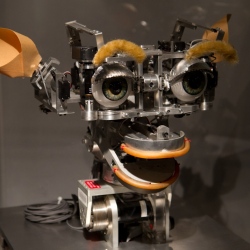
In 1996, Jan Scheuermann was diagnosed with spinocerebellar degeneration, a hereditary condition in which areas of the spinal cord and brain that control movement deteriorate. She gradually became quadriplegic, losing the use of her arms and legs. But researchers at the University of Pittsburgh’s Pitt School of Medicine sought to give Scheuermann control back, not of her own arm, but of a robotic arm she would control with her own thoughts.
The brain-computer interface (BCI) that surgeons implanted consisted of two quarter-inch arrays containing 96 electrode contacts. The arrays were placed on the surface of Scheuermann’s motor cortex – one over the area that is activated when she thinks about moving her hand, the other over the area activated when she thinks about moving her shoulder. The arrays are able to detect the electrical activity of underlying neurons and use the firing patterns to control a robotic arm.
Scheuermann showed rapid progress during training. Within a week she was able to move the arm in and out, left and right, and up and down. Within a year of training she had become proficient enough at controlling the arm that she was able to feed herself a chocolate bar. The task had become relatively easy, she needed only to think of where she wanted the arm to go and it moved there, the researchers said, with the coordination, speed and skill comparable to an able-bodied person.
